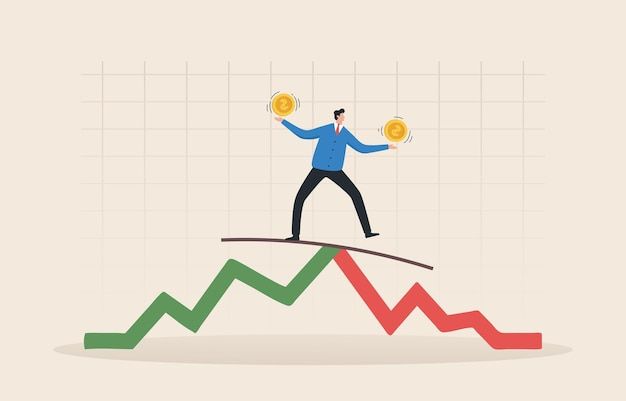The stock market, in its very essence, is a paradox. It is a powerful engine for long-term wealth creation, yet it is also a place of constant, often stomach-churning, fluctuation. For many investors, the word “volatility” conjures images of flashing red arrows, alarming news headlines, and the unnerving feeling of watching their hard-earned capital seemingly evaporate overnight. This fear is a primal, powerful force that can drive even the most rational individuals to make disastrous financial decisions.
However, the most successful investors throughout history share a common secret: they view volatility not as a threat, but as an opportunity. They understand that market swings are not a sign that the system is broken; rather, they are a normal, inevitable feature of a healthy, functioning market. The chaotic dance of rising and falling prices is what creates the potential for growth. Without risk, there can be no meaningful reward.
The key to navigating this turbulent environment is not to predict the market’s next move—a fool’s errand that has humbled countless experts. Instead, the goal is to build a robust, resilient investment strategy and cultivate an unshakable mindset that allows you to endure the storms and capitalize on the opportunities they create. This is not about complex algorithms or risky day-trading tactics. It is about embracing timeless principles that separate seasoned investors from panicked speculators.
This definitive guide is designed to be your anchor in the storm. We will move beyond the headlines to deconstruct what market volatility truly is, explore its underlying causes, and, most importantly, provide a clear, actionable framework of strategies to protect your portfolio, manage your emotions, and turn market turbulence into your greatest advantage. By internalizing these concepts, you can transform fear into confidence and learn to master the market’s inevitable cycles.
The Nature of Market Volatility
Before one can conquer a challenge, one must first understand it. Stock market volatility, at its core, refers to the magnitude and speed of price changes for a market index or an individual stock. High volatility means prices are swinging dramatically over a short period, while low volatility indicates a more stable, predictable pricing environment.
It’s helpful to think of volatility as the market’s “heartbeat.” A flat line would mean the market is dead; a steady, rhythmic pulse indicates normal activity; and a rapid, erratic beat signifies a period of high stress and uncertainty. While stressful, these erratic periods are temporary. The primary drivers behind these fluctuations are numerous and often interconnected.
A. Economic Data Releases: Key economic indicators have a profound impact on investor sentiment. Reports on inflation (like the Consumer Price Index), employment numbers, Gross Domestic Product (GDP) growth, and manufacturing data can all trigger significant market reactions as they offer a glimpse into the health of the economy.
B. Interest Rate Policy: Central banks, such as the U.S. Federal Reserve, wield immense influence. The mere suggestion of raising or lowering interest rates can send shockwaves through the market. Higher rates typically make borrowing more expensive, which can cool down the economy and corporate profits, while lower rates can stimulate growth.
C. Geopolitical Events: Global events, from international conflicts and trade disputes to political instability and natural disasters, create uncertainty. Markets despise uncertainty, and this ambiguity often leads to sell-offs as investors flee to perceived “safe-haven” assets.
D. Investor Sentiment and Psychology: Perhaps the most potent driver of short-term volatility is collective human emotion. The pendulum of fear and greed is a powerful force. Exuberant optimism can inflate bubbles, while widespread panic can cause market crashes that overshoot the underlying fundamental reality. Financial news cycles and social media often act as amplifiers for these emotions.
The Investor’s Toolkit: Core Strategies for Thriving in Volatility
Navigating a volatile market successfully is not about making radical moves. It’s about a disciplined adherence to a set of core principles designed to mitigate risk and harness long-term growth.
A. Embrace a Long-Term Horizon
The single most powerful tool an investor possesses against volatility is time. Short-term market movements are notoriously random and unpredictable. Trying to “time the market”—selling at the peak and buying back at the bottom—is a statistically losing game. For every person who gets it right once, thousands get it wrong, missing the market’s best recovery days and locking in their losses.
The historical data is unequivocally clear: despite numerous wars, recessions, and crashes, the stock market’s trajectory over the long run has been consistently upward. By adopting a long-term perspective (thinking in terms of years and decades, not days and weeks), you allow the power of compounding to work its magic and ride out the short-term noise. Your focus shifts from the current price of a stock to the long-term value of the underlying business.
B. Diversification: The Only Free Lunch in Investing
The age-old adage, “Don’t put all your eggs in one basket,” is the cornerstone of intelligent portfolio construction. Diversification is the practice of spreading your investments across various assets so that the poor performance of a single investment does not torpedo your entire portfolio.
- Across Asset Classes: True diversification means looking beyond just stocks. A well-balanced portfolio should include a mix of different asset classes that behave differently in various economic conditions. This includes stocks (for growth), bonds (for stability and income), real estate (for income and inflation hedging), and commodities (like gold, which can act as a safe haven).
- Within Asset Classes: Within your stock allocation, diversification is still crucial. Spread your investments across different sectors (e.g., technology, healthcare, consumer staples, energy) and industries. This prevents you from being overexposed if one specific sector faces a downturn.
- Geographic Diversification: Don’t limit your investments to your home country. Allocating a portion of your portfolio to international developed markets and emerging markets can provide exposure to different growth cycles and protect you from localized economic slumps.
C. Dollar-Cost Averaging: Automate Your Success

One of the best ways to combat the emotional pitfalls of investing in a volatile market is to automate the process. Dollar-Cost Averaging (DCA) is a simple yet profoundly effective strategy where you invest a fixed amount of money at regular intervals (e.g., $500 every month), regardless of what the market is doing.
This discipline offers two key advantages:
- Psychological Benefit: It removes emotion from the equation. You no longer have to agonize over whether it’s the “right time” to buy. Your investment plan is on autopilot, forcing you to remain consistent even when fear is telling you to run.
- Mathematical Benefit: When the market is down, your fixed investment amount automatically buys more shares. When the market is up, it buys fewer shares. Over time, this can lead to a lower average cost per share than if you had tried to time your purchases, enhancing your potential returns when the market recovers.
D. The Discipline of Rebalancing
Over time, as some of your investments perform better than others, your portfolio’s original asset allocation will drift. For example, a strong bull market in stocks might cause your portfolio, which you initially set at a 60/40 stock-to-bond ratio, to become a 75/25 ratio. You are now taking on more risk than you originally intended.
Rebalancing is the disciplined process of periodically selling some of the assets that have performed well and buying more of the assets that have underperformed to return to your target allocation. This forces you to systematically “sell high and buy low.” It’s a counter-intuitive practice that helps manage risk and often enhances long-term returns by preventing your portfolio from becoming too concentrated in an overvalued asset class.
E. Focus on Quality and Fundamentals
In a bull market, even low-quality companies can see their stock prices rise with the tide. However, when the tide goes out during a downturn, these are the companies that are often exposed and suffer the most. Volatility serves as a powerful reminder to focus on the fundamental quality of the businesses you invest in.
Look for companies with durable competitive advantages (often called a “moat”), strong balance sheets with manageable debt, a history of consistent earnings and revenue growth, and competent, shareholder-friendly management. These are the resilient businesses that have the financial strength to not only survive an economic storm but to emerge from it even stronger by gaining market share from weaker competitors.
Managing the Most Volatile Element: Your Mind

The greatest risk in a volatile market is not in your portfolio; it is in the mirror. Investor psychology is the single biggest determinant of long-term success or failure.
- Tuning Out the Noise: The 24/7 financial news cycle is engineered to trigger emotional responses. Sensationalist headlines and “expert” predictions are designed to generate clicks, not to make you a better investor. Learn to disconnect from the daily chatter and focus on your long-term plan.
- Having a Written Investment Plan: Before the storm hits, you need a map. A written investment policy statement (IPS) outlines your financial goals, risk tolerance, and the specific strategies you will employ. When you are feeling panicked, this document serves as a rational reminder of your long-term objectives and the rules you set for yourself when you were thinking clearly.
- Viewing Downturns as Opportunities: This mindset shift is a game-changer. Instead of seeing a market correction as a loss, begin to see it as a sale. When a high-quality company you’ve always wanted to own sees its stock price drop 30% due to broad market panic, that’s not a disaster—it’s an opportunity to buy a great business at a discount.
In conclusion, mastering market volatility is a journey of strategy, discipline, and psychological fortitude. It requires accepting that you cannot control the market, but you can control your own behavior. By building a diversified, high-quality portfolio, embracing a long-term perspective, automating your investments through dollar-cost averaging, and adhering to a disciplined rebalancing strategy, you build a fortress against the storms. More importantly, by understanding and mastering your own emotions, you can transform the market’s greatest perceived risk into your most powerful ally for building lasting wealth.












